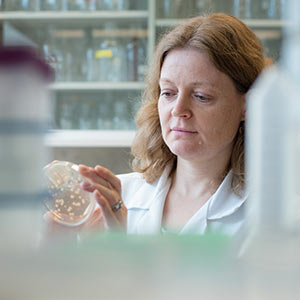
Vivien Measday
Associate Professor, Wine Research Centre
Associate Member – Department of Biochemistry and Molecular Biology
Associate Member – Michael Smith Laboratories, Genomics Group
604–827–5744
FNH 325, 2205 East Mall
University of British Columbia, 2003, Post-doctoral Research, Dept. Medical Genetics
University of Toronto, 1998, PhD, Dept. Medical Genetics and Microbiology
University of British Columbia, 1991, BSc, Dept. Biochemistry
Wine Yeast Research
My research focuses on the study of yeast populations associated with the vineyards of British Columbia’s Okanagan Valley. We partner with the BC Wine Grape Council and associated wineries to perform spontaneous fermentations and isolation of the wine yeast Saccharomyces cerevisiae (S. cerevisiae). Using high-throughput genotypic analyses, we generate a genetic fingerprint of each S. cerevisiae strain and compare it to a fingerprint database of S. cerevisiae commercial wine yeast strains that we have generated. Our goal is to identify S. cerevisiae indigenous to the Okanagan Valley with enological potential. We collaborate with Dr. Dan Durall’s laboratory at UBC-Okanagan to achieve this goal.
Projects
- Survey of yeast populations associated with Pinot Noir grapes in 3 Okanagan sub-regions: Oliver-Osoyoos, Penticton-Naramata, Kelowna
- Comparison of yeast populations in Pinot Gris and Pinot Noir winery versus vineyard fermentations
- Isolation and characterization of non-Saccharomyces yeast isolated from spontaneous fermentations
- Characterization of Saccharomyces uvarum associated with Okanagan white wine fermentations – in collaboration with Dr. Dan Durall’s lab
- Fungal community identification from Pinot Noir and Pinot Gris fermentations using high-throughput Illumina amplicon sequencing
Retrotransposon Research
My lab uses S. cerevisiae as a model system to study retrotransposition. Retrotransposons are repetitive DNA elements in the genome that can replicate and insert a new copy into the genome via an RNA intermediate. We study the Ty1 retrotransposon which has a structure and life cycle similar to human immunodeficiency virus type 1 (HIV-1) except that Ty1 does not exit the cell. Our focus is to identify host factors that interact with integrase, a conserved protein that is required for insertion of retroviral/retrotransposon DNA into the genome.
Projects
- Characterization of the interaction between RNA Polymerase III and Ty1-Integrase
- The role of the Nuclear Pore Complex in Ty1element genome integration
Cheng, E.*, Martiniuk, J. T.*, Hamilton, J., McCarthy, G., Castellarin, S. D. and Measday, V. (2020) “Characterization of Sub-Regional Variation in Saccharomyces Populations and Grape Phenolic Composition in Pinot Noir Vineyards of a Canadian Wine Region”, Frontiers in Genetics, https://doi.org/10.3389/fgene.2020.00908
*these 2 authors contributed equally to this work
Cheung, S., Manhas, S. and Measday, V. (2018) “Retrotransposon targeting to RNA Polymerase III-transcribed genes”. Mobile DNA, April 23; 9:14.
Manhas, S., Ma, L. and Measday, V. (2018) “The yeast Ty1 retrotransposon requires components of the Nuclear Pore Complex for transcription and genomic integration” Nucleic Acids Research 2018 Apr 20; 46(7)3552-3578.
Martiniuk, J.T., Pacheco, B., Russell, G., Tong, S., Backstrom, I. and Measday, V. (2016) “Impact of Commercial Strain Use on Saccharomyces cerevisiae Population Structure and Dynamics in Pinot Noir Vineyards and Spontaneous Fermentations of a Canadian Winery” PLOS ONE, Aug 23;11(8):e0160259
Cheung, S., Ma, L., Chan, P.H., Hu, H.L., Mayor, T., Chen, H.T. and Measday, V. (2016) “Ty1 integrase interacts with RNA Polymerase III-specific subcomplexes to promote insertion of Ty1 elements upstream of Polymerase (Pol) III-transcribed genes” Journal of Biological Chemistry, Mar18; 291(12): 6396-411